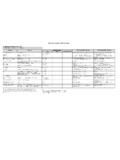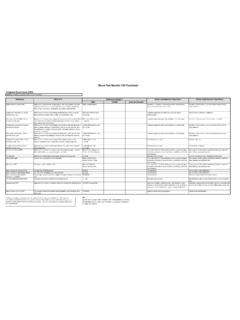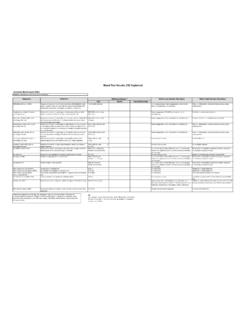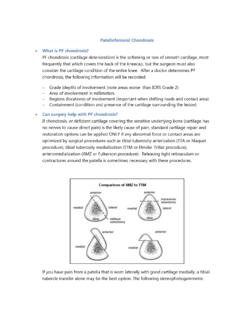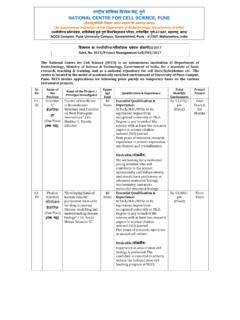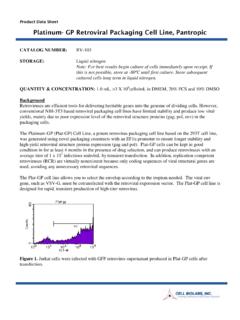Transcription of Haematopoietic Stem Cell Mobilisation and …
1 Haematopoietic stem Cell Mobilisation and Apheresis: A Practical Guide for Nurses and Other Allied Health Care Professionals I. The European Group for Blood and Marrow Transplantation gratefully acknowledges the following individuals for their critical review and contributions to this guide: Erik Aerts (RN) Switzerland Aleksandra Babic (RN) Italy Hollie Devine (RN) USA. Francoise Kerache (RN) Germany Arno Mank (RN) Netherlands Harry Schouten (MD) Netherlands Nina Worel (MD) Austria Haematopoietic stem Cell Mobilisation and Apheresis: A Practical Guide for Nurses and Other Allied Health Care Professionals Table of Contents Chapter 1: Overview of Autologous Haematopoietic stem Cell Transplantation.
2 1. Chapter 2: Mobilisation .. 5. Chapter 3: stem Cell Collection (Apheresis), Storage, and Reinfusion.. 13. Chapter 4: How to Discuss Noted Topics With Patients.. 19. Glossary .. 23. References.. 24. Additional Resources .. 27. Notes.. 28. Table of Contents Chapter 1: Overview Chapter 1: Overview of Autologous Haematopoietic stem Cell Transplantation Widely accepted cancer treatment strategies include chemotherapy and radiotherapy. The rationale for administration of high-dose chemotherapy and/or radiation to patients with therapy-sensitive tumours is to reduce tumour burden. Delivery of these therapies with respect to higher drug doses and intensified schedule are often limited by organ toxicities (eg, bone marrow, heart, and lung) and pancytopenia.
3 To overcome these dose limitations, autologous Haematopoietic stem cell transplantation (AHSCT), high-dose therapy supported by the infusion of Haematopoietic stem cells , has evolved as a medical procedure to allow for administration of intense drug doses with tolerable organ and Haematopoietic toxicity. Infusion of autologous stem cells following dose-intensive treatment rescues the bone marrow by re-establishing normal haematopoiesis. Upon regeneration of bone marrow function, patients may be cured from their disease or receive additional cancer ,2. Autologous Haematopoietic stem cell transplantation is a complex medical procedure that has been used to treat and cure patients with various malignant and non-malignant disorders.
4 Although the first documentation of AHSCT use to treat cancer was reported in the 1890s,3 achievement of a cure in patients with a malignancy was only documented in 1978 following a clinical trial conducted at the National Cancer Institute (United States).4. Subsequent to this report, numerous advances have been made in the art of AHSCT and thousands of patients around the world have had their diseases successfully managed through the use of AHSCT. The term autologous Haematopoietic stem cell transplantation is frequently used interchangeably with the terms autologous bone marrow transplantation (aBMT), autologous peripheral blood stem cell transplantation (aPBSCT), and autologous Haematopoietic cell transplantation (AHCT).
5 5 Autologous means that the donor cells used for the procedure are from the patient himself, as opposed to allogeneic, which refers to a cell donor other than the patient. In certain allogeneic circumstances, the term syngeneic is used when the cell donor is a patient's identical twin. The source of stem cells for collection is identified by the terms bone marrow and peripheral blood. cells for the patient may be collected either from the donor's bone marrow reserves, such as those stored in the iliac crest of the pelvic bones, or from the donor's peripheral blood. Additionally, umbilical cord blood (UCB), found in the umbilical cord and placenta following childbirth, is another source of progenitor stem cells used in clinical practice in the setting of allogeneic When 2 autologous stem cell transplantations occur in a scheduled, sequential fashion, this process is referred to as tandem autologous stem cell transplantation.
6 6,7. In the more than 3 decades following the first successful use of AHSCT, the utility of this treatment for malignant and non-malignant conditions has been well established (Table 1).8 In the setting of relapsed malignant conditions, standard chemotherapy regimens may produce unacceptable rates of bone marrow suppression (myelosuppression), resulting in a low white cell count, low platelet count, and anaemia. This increases the risk of potentially fatal infections and bleeds. Following chemotherapy, the patient is therefore given a transplant of stem cells to regenerate damaged bone marrow. Thus, the reinfusion of autologous stem cells has become a therapeutic modality for reducing prolonged Data demonstrate that high-dose therapy with stem cell rescue has a positive impact on disease response rates; however, for some patients it fails to improve overall survival when compared to conventional chemotherapy treatments.
7 Thus, the definitive role of AHSCT in certain situations, such as the treatment of refractory or relapsed Hodgkin's lymphoma or chronic lymphocytic leukaemia, remains inconclusive12-15 and indications for AHSCT continue to evolve. Chapter 1: Overview of Autologous Haematopoietic stem Cell Transplantation 1. Table 1. Indications for Autologous Haematopoietic stem Cell Transplantation in Adults8. Investigational or Optional Based on Generally Not Disease Standard of Care Additional Trials Risks and Benefits Recommended Needed Acute lymphoid CR1 (standard, CR2 (incipient relapse). leukaemia intermediate or high risk) Relapsed or refractory disease Acute myeloid CR1 (intermediate risk) CR1 (low or high risk) CR3 (incipient relapse).
8 Leukaemia M3 (molecular CR2) CR2 M3 (molecular persistence). Relapsed or refractory disease Chronic lymphoid Poor risk disease leukaemia Chronic myeloid leukaemia First (CP), failing imatinib Blast crisis Accelerated phase or >. first CP. Myelofibrosis Primary or secondary with an intermediate or high Lille score Myelodysplastic RAEBt RA. syndrome sAML in CR1 or CR2 RAEB. More advanced stages Diffuse large Chemosensitive relapse; CR1 (intermediate or high Refractory disease B-cell NHL CR2 IPI at diagnosis). Mantle cell CR1 Refractory disease lymphoma Chemosensitive relapse;. CR2. Lymphoblastic CR1 Refractory disease lymphoma and Chemosensitive relapse.
9 Burkitt's lymphoma CR2. Follicular B-cell NHL Chemosensitive relapse; CR1 (intermediate or high Refractory disease CR2 IPI at diagnosis). T-cell NHL CR1 Chemosensitive relapse; Refractory disease CR2. Hodgkin's lymphoma Chemosensitive relapse; Refractory disease CR1. CR2. Lymphocyte predominant Chemosensitive relapse; CR1. nodular Hodgkin's CR2. lymphoma Refractory disease Multiple myeloma . Amyloidosis . Severe aplastic anaemia . Paroxysmal nocturnal . haemoglobinuria Breast cancer* Adjuvant high risk disease Metastatic Metastatic responding responding Germ cell tumours Third-line refractory Sensitive relapses Ovarian cancer CR/PR Platinum-sensitive relapse Medulloblastoma* Post-surgery Post-surgery Small cell lung cancer Limited disease Renal cell carcinoma Metastatic, cytokine-refractory Soft cell sarcoma Metastatic, responding Immune cytopenias.
10 Systemic sclerosis . Rheumatoid arthritis . Multiple sclerosis . Systemic lupus . erythematosus Crohn's disease . Chronic inflammatory . demyelinating polyradiculoneuropathy CP, chronic phase; CR1, 2, 3, first, second, or third complete remission; CR/PR, complete response/partial response; IPI, International Prognostic Index; NHL, non-Hodgkin's lymphoma; RA, refractory anaemia; RAEB, refractory anaemia with excess blasts; RAEBt, refractory anaemia with excess blasts in transformation; sAML, secondary acute myelogenous leukaemia; indicates use of autologous Haematopoietic stem cell transplantation regardless of stage.

